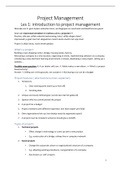Samenvatting
Volledige Samenvatting Project Management-EPM-Artevelde
- Instelling
- Arteveldehogeschool (Artevelde)
Volledige Samenvatting Project Management. Veel afbeeldingen. Taal: Engels en soms ter verduidelijking Nederlands Docent: Denis De Bruyne Hoofdstukken: Les 1: introduction to project management Les 2: People working on projects Les 3: Stakeholder management Les 4: The project from start to fi...
[Meer zien]



